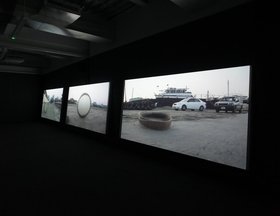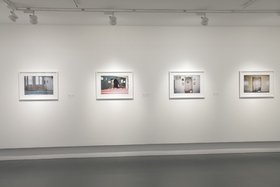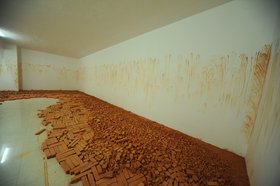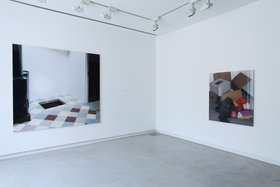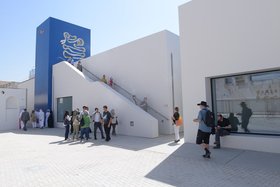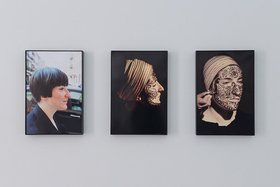Essays
RE:EMERGING, DECENTRING AND DELINKING
Shifting the Geographies of Sensing, Believing and Knowing
I
The Sharjah Biennial 11 was, without a doubt, an unmistakable statement: a signpost of a global shift that cuts across economics, politics, culture, art, aesthetics, religion and sensibilities. But the four spectacular days of SB11's inauguration (judging by the press coverage) should not obscure something that, I suspect, will transcend the two months the exhibit will remain open to the public (13 March-13 May 2013).[1]
The first time I read about Sharjah Biennial 11 was in Hong Kong. No event of this kind had caught my attention before as this one did and I wanted to know more. I had the suspicion that something distinctive was in the making. Yuko Hasegawa, Chief Curator of the Museum of Contemporary Art in Tokyo, was appointed to curate the Sharjah Biennial in the United Arab Emirates. Could this exhibition become what I was sensing and expecting at the time? A statement by Hasegawa particularly stood out:
Sharjah is historic and present, social, natural, and political. It is a place that encourages thinking and negotiating with others. My natural response to its dynamism is to produce a biennial which asks questions through art, and creates a dialogue that liberates us from Eurocentrism, Globalism, and other relevant -isms. [2]
In the hope that my intuitions would be confirmed, I vowed to follow up on the unfolding of Sharjah Biennial 11. When the title was announced, my heart jumped:
In Re:emerge, Towards a New Cultural Cartography, curator Yuko Hasegawa proposes a biennial that reassesses the Westerncentrism of knowledge in modern times and reconsiders the relationship between the Arab world, Asia, the Far East, through North Africa and Latin America. [3]
The reason I was in Hong Kong (January to June 2012) was to learn and 'feel' what was already announced as the 'irreversible shift to the Eastern Hemisphere.'[4] I saw an extraordinary parallel between the statement just quoted here by the Dean of Lee Kuan Yew School of Public Policy in Singapore, Kishore Mahbubani, and the statement of Hasegawa, the Chief Curator of the Museum of Contemporary Art in Tokyo. Today, one feels that, with the collapse (financial, political and ethical) of the European Union and the critical moments currently taking place in the USA both domestically and internationally, we are living a change of epoch, not an epoch of change. Things are shifting; centres are moveable; sensibilities are shifting the illusion of the end of history after 500 years of localized western history; consolidation and domination is ending. Older – much older – histories of civilizations are re-emerging. Globalism (the neoliberal vision of homogenizing the planet) is spinning out of control and every western universal is under siege.
In this fair-haired age of Biennials, Triennials and Quinquennials, there is an anxiety to be the 'newest' and a fear of being 'behind' on the latest artistic and aesthetic theories. It is refreshing and empowering to have a biennial exhibition like the Sharjah Biennial, which turns its back on the intellectual Euro-American fashions that have dominated, until recently, the '-ennial' market place. Sharjah Biennial 11 drastically deviates our attention from this codification in such events and forces us to revise our assumptions about what art is, what 'biennials' are, and what cultural cartographies we have been accustomed to until now. Sharjah Biennial 11 undeniably achieved what most events that mark a turning point generally accomplish – it announced the desuetude of deep-seated ways of thinking, giving us 'an other' conceptual and historical narrative. Re:emerge, Towards a New Cultural Cartography opens up the silenced and marginalized creativity of the 'Global South' and 'Global East'. What has been announced with Sharjah Biennial 11 is nothing less than the end of an illusion of the successful fiction of western modernity from the European Renaissance through to the European Enlightenment right through to the end of the twentieth century.
II
Sharjah Biennial 11 marks a 'change of epoch'. No longer is the world dominated by the local Euro-American historical narrative of the 'epoch of changes'.[5] Next to this, and not after, we now have an option that both marks the limits of modernity and its sequels (postmodern, altermodern, postcolonial), while contributing to global processes of epistemic and aesthetic disobedience. To understand the radical break produced by SB11, it suffices to look at the history of the Sharjah Biennial up to this point and to look at it in relation to events in Europe that attempted to introduce departures and new roads within Europe's local history: Kassel Documenta 11 (2002), curated by Okwui Enwezor and the Tate Modern Triennial in 2009, Altermodern, curated by Nicolas Bourriaud.
The previous Sharjah Biennials (1 to 10) were indeed magnificent events, but still within the expectations of how such an artistic event is enacted. Distinguished curators are invited, the curator and the organizing institutions decide on a topic and a title and artists whose work are perceived to be within the topic range are invited to flesh out the title and the statement. In many ways, the radical shift we have been exposed to in Re:emerge was already announced in the previous Sharjah Biennials. In the beginning, the novelty was that this type of event was supposed to happen in western Europe or the USA, perhaps Japan, but not in the United Arabs Emirates. But when the biennial as an institution moved from western Europe – where it originated – to the Middle East, the result was not an imitation nor was it indicative of a desire to have in the Middle East what Europe had. On the contrary, it was to appropriate the form of the biennial to do what it was not doing in Europe: open spaces for artists, memories, cultures, languages, sensing and knowledge to come together beyond Europe.
As for Documenta 11 and Altermodern, these were two events in which curators responded to the changing world at the beginning of the twentieth century. Europe could no longer be self-contained. Okwui Enwezor, curator of Documenta 11, projected an event inscribed in the 'postcolonial constellation'[6] aiming at a 'new geography of culture' and a 'transnational vision of art.' The result was endocentric: it was bringing the world to Europe. Nicolas Bourriaud's Altermodern was similar in logic but different in content. The 'altermodern constellation', if I can say so, contested Enwezor's 'postcolonial constellation' and, like the postmodern and the postcolonial, remained within the confines of Europe. He was explicit about the project when he described it as being 'From the Margins to the Centre.'[7] The difference was in the artists they selected and in the dialogue both curators established with European modern and postmodern concepts or art and aesthetics: the first departed toward the postcolonial, the second toward the altermodern.[8] Yuko Hasegawa departed from both: neither postcolonial nor altermodern (both Eurocentered) but dewesternizing (decentred and pluri-centred). Re:emerge turned its back to the 'centre', multiplied the centres and focused on the creativity of previously disavowed localities and people. [9]
III
In Re:emerge, Yuko Hasegawa drastically and unapologetically turned the tables around. Not in reverse, but around. Sharjah was neither 'Orientalism in reverse' nor 'cultural relativism in the postcolonial era' as one spectator apparently commented.[10] But to make sense of what the Sharjah Biennial entails, we need a de-colonial rather than postmodern or postcolonial vocabulary. In starting from the institution of the 'biennial' and brazenly departing from it, Hasegawa appropriated the exhibition to do something else: dwell in the border and engage in border thinking, sensing and doing. It was a departure: a critique of Eurocentrism and a 'western-centrism of knowledge' (both embedded in Documenta 11 and Altermodern) to build something different. The difference is a radical decentring rather than reversing of European modernity's legacies.
Hasegawa was clear in this regard: that her project was not 'anti' but rather critical and prospective. This means that de-westernization and de-coloniality are always unveiling the injustices of the past and projecting global and pluri-centered futures. That is precisely what 're-emerge' means. And it is linked not only to the idea of culturally 're-emerging' but in the larger context of the irreversible shift to the Eastern Hemisphere and the 'Global South'. Hasegawa had a clear and wide vision of her project. She states:
A Western perspective once dominated the debate about globalisation, but things have changed. … After the process of modernisation and colonialisation we have seen various intercultural shifts […] it is especially evident in Hong Kong, Singapore, New Delhi and Sharjah over the last ten years, where they have developed economically but also politically, having taken on their own initiative and identity. Also the traditional empires of China, Turkey and India are re-emerging in a new contemporary format. I am not trying to simply criticise a Eurocentric viewpoint but hoping we can re-orientate ourselves and shift our point of view. This is the new contemporary that I am talking about.[11]
Out of almost 100 participating artists, two were from the USA and 20 from Europe, less than 20 per cent of the total. The Sharjah Bienial is not just an event to be remembered. It is an event that will be continued in other places of the 'Far East' and the 'Global South' and hopefully in the south and east of the 'Global North'. Furthermore, in the above statement, you can see in bold letters what 'de-westernization' (in the sense of de-centring and de-linking) means. The vision and execution of Re:emerge finds its force, as the above statement illustrates, in the fact that it is not isolated and echoes the thoughts and sentiments of many in the places Yuko Hasegawa mentions for Re:emerge. But let me say two words on the question of the 'West', 'East', or 'Global South', since this is helpful in understanding the shift that Re:emerge is both announcing and paving the way for.
The west/east divide is not ontological. There is nothing on the planet that tells us about it. 'West' and 'East' are two western concepts that rest on the inventions of 'Indias Occidentales' (1494) and 'Indias Orientales' (1529), when the planet was appropriated and divided between the Spanish and Portuguese crowns. What came later was already established. When Rome lost its central place between the 'two Indies', the rules of the game were already laid down and controlled by western knowledge. 'West' and 'East' were located in relation to Rome (the centre of the enunciation), which displaced Jerusalem after Christians lost hold of it during the Crusades. When the line moved to the Greenwich Meridian and Rome lost its central place to London, the only change was that instead of 'Indias Occidentales' and 'Indias Orientales' in Spanish, the vocabulary turned to 'West' and 'East' in English.
The epistemic and cultural privilege of European modernity is over, as is the politico-economic privilege. The shift to the eastern hemisphere and the 'Global South' is founded in both economic growth and cultural confidence. Hasegawa noticed that the artists of the 'Global South' and 'Far East' are using the same techniques originating in the west, but privileging identity when using them. A parallel with the global economic order is in place: the planetary economic order is capitalist, but the BRICs countries are acting on politico-economic state identities and delinking from the IMF and the World Bank.[12] Dignity is at stake at every level here, for the simple reason that identity is what Eurocentrism taught the rest of the world to despise so as to become modern (postmodern or altermodern), developed and 'civilized'. Hasegawa noticed, precisely, that in the past decade or so, artists from the 'Global South' and the 'Far East' have been using similar techniques but are becoming more and more concerned with how these might be used to make individual and communal memories – the memories of their communities and countries – re-emerge.
The 'courtyard' was Hasegawa's statement to use and undo the Sharjah Biennial as an institution. It was in that spirit that she responded by taking the courtyard as the central metaphor of the exhibit. In an interview with Hasegawa, Stephanie Bailey asked if 'the metaphor of the garden feels representative of a global territory where distinctions are blurring and merging,' to which Hasegawa responded:
Yes, and it is also this idea of the place of memory. That is very important for a culture. So this was my orientation towards curating this biennial with the consciousness but you also have to contribute, too, to the space you are interacting or engaging with. [13]
'Place of memory'; 'local consciousness'…Yes, indeed. That is what shifting the geography of knowing and sensing means: one could not 're-emerge' by pegging one local temporality to the linear local temporality of Euro-centred modernity (and its corollaries). It is no longer necessary to start from Greece and Rome. That is what the 'courtyard' means: it is not the place of the Muses, or the solitary place of study, but a place where inside and outside meet – where people live and pass each other. It is also a place where cultural identity is rooted. But above all, the 'courtyard' is rooted in the histories and memories of Persian and Arab civilizations, as much as ancient Greece's white columns and Roman aqueducts are embedded in the local memories of western civilization.
In her preface to the event's catalogue, Hasegawa gives a longer explanation of the 'courtyard' as the special and temporal anchor of Sharjah Biennial 11:
Courtyards, unlike gardens in the West, which can be viewed from the outside- Islamic courtyards are social spaces that must be experienced from inside, including smell, touch and sound. The courtyard was incorporated wherever Islam extended its influence-in Sicily, Southern Spain, the coastal regions of North Africa and the Ottoman Empire.[14]
Hasegawa noted that all the artists invited to show at SB11 – and particularly the 80 per cent from the non-European world – embed their work in their own local memories and histories. In many ways Hasegawa has done the same by using the meaning and memories of the courtyard garden in Islamic civilization as a place of memory. But it is not only memories inscribed in the present but also the senses: smell, touch and sound. In this light, producing a biennial like this is in itself a radical shift in the geopolitics of knowing, sensing and believing.
The 'courtyard' in Persian and Arab Islam, like the constellation of stars known as the 'Southern Cross' in the South American Andes, are anchors of memories, social organizations, and patterns of living spaces. They are both places of memories and collective consciousness – one is terrestrial, the other celestial, but they have similar functions. I learned from my Muslim colleagues at Duke University that the Persian philosopher Al Ghazali (1058-1111) was informed in his thinking by the courtyard. Ebrahaim Moosa explained to me that dihliz – 'that space between the door and the house' – is a Persian word that has been 'Arabized'. In trying to understand why this concept was so crucial for Al Ghazali, Moosa speculates: 'What one slowly begins to fathom is that the dhiliz, of the dihliz-ianspace is a liminal space as well as the action of two entries: entry from the outside and entry into the inside.' [15]
Al Ghazali was living and thinking in a polycentric world order (no civilizations ruled or imposed upon other civilizations) with non-capitalist economies. Today, we have Moroccan philosopher and feminist Fatima Mernissi who has been reflecting on the subjective impact of the courtyard. She tells her readers: 'My childhood was happy because the frontiers were crystal clear. The first frontier was the threshold separating our family's salon from the main courtyard'. Later she said: 'I would sit on our threshold and look at our house as I had never seen it before. First, there was the square of the rigid courtyard, where symmetry ruled everything.' Further on, Mernissi continues: 'Looking at the sky from the courtyard was an overwhelming experience. At first, it looked tame because of the man-made square frame. But then the movement of the early morning's stars, fading slowly into deep blue and white, became so intense that it could make you dizzy.'[16]
How important is this? I grew up in Argentina, in a small town in the countryside. During the summer nights in the front garden of my parent's house (not a courtyard), I would sit on a lazy-boy and look at the magnificent splendours of the southern sky. I pondered on the constellation known as the 'Southern Cross 'and still use that reference, after 40 years in the 'Global North', thinking about how the Incas in the South American Andes built a whole cosmology and social organization based on the model of the 'Southern Cross'. And so it is for the courtyard in the Islamic, Persian and Arab worlds. In these 'spaces' contains the sensibility, memories and world sensing that you simply cannot find in London, Berlin, Paris or New York. You can have other substitutes, of course: there are other ways of bringing into being such a 'place-sensing' experience. And that is fine. But what is not fine is to expect the universalization of western localities and sensibilities, simply because you cannot universalize the local without erasing the localities of others. That was and is the problem with the Eurocentred idea of modernity. Once, people around the world believed that 'the way' was to embrace western modernity. Now, the trick has been uncovered and the departures have already begun. They are wide and far spread.
Interestingly enough – and that is one of the lasting lessons of Re:emerge – there is not one universality for which only 'someone' has the key. This is what the 'western-centrism of knowledge' means in Yuko Hasegawa's expression of it: to possess the key to all doors of knowledge, culture, subjectivity, religion, economy and politics – and every thought related to the management of population and nature. Of course, that was true, but it is no longer the case. For that reason, Sharjah Biennial 11 is a single event but one that is already part of a larger global unfolding. Histories are not ending, they are changing orientations: they are 're-orienting' themselves as Yuko Hasegawa would say, invoking the title of Andre Gunder Frank's book. [17]
IV
Let's take another look at the period leading up to the 1500s. The planet was polycentric and non-capitalist. Many civilizations and cultures coexisted. There were inequalities within each civilization then as much as they are now, but no one single civilization dominated the others. Until 1500, the planet housed many civilizations, none of them centred on a capitalist economy (for example, the economy of reinvesting the surplus in order to increase gains and wealth, disregarding the consequences). Then, the long night of European modernity began. First, the Renaissance was invented and with it the coming into being of 'Western Civilization' (the youngest on the planet). The European Renaissance meant Death (with a capital D) for the ancient civilizations (Maya, Aztec, Inca) of what came to be known as America. Then, the Enlightenment followed suit and reduced Asia and Africa to Darkness and Barbarism. That 'fiction' lasted until about 2000.
The idea that economy means growth, development and accumulation (and not the administration of scarcity) is today global. Inequalities subsist, but the global order is no longer and solely in the hands and minds of European and the USA. The BRICs countries are disputing political and economic control. In this vein, we can read Sharjah Biennial 11 entering into dispute with 'Western' hegemony in the sphere of culture, knowledge, aesthetics and, above all, sensibility. (Aesthesis, from where the word aesthetics is derived.) What is indeed 're-emerging' is the dignifying creativity that does not reverse but erases Orientalism.
Western epistemic, economic, political and cultural hegemony was possible because the construction and management of knowledge was in the hands and heads of European actors, in European languages and supported by European institutions. 'Western-centrism of knowledge' means that sustainable knowledge was cast in six modern European imperial languages based on Greek and Latin. This is not a geographical but an epistemic concept. In this, we should understand the subtitle of Sharjah Biennial 11, Towards a New Cultural Cartography, as an epistemic and aesthetic shift rather than only a geographical one. These geo-historical locations matter precisely because the planet we live on was mapped through and by western cartographic knowledge: 'First, Second and Third Worlds' is a recent example of ranking and racializing locales.
Notions like 'return' and 're-emerging' have flagged the diverse planetary consciousness currently delinking from Eurocentrism. It means, as Hasegawa points out, not only economic growth but also 're-learning'. That is, learning to re-learn and build on identities that the dominance of western knowledge taught them (us) to despise. In complimentary ways, Sheikha Hoor Al-Qasimi, [18] President of the Sharjah Art Foundation, underlines the importance of re-inscribing the past in the debate of the present not only to build economic, political and multipolar worlds but also pluriversal, epistemic, aesthetic and religious subjectivities.[19]
Sheikha Hoor Al-Qasimi is another key figure in both the vision and the making of Sharjah Biennial 11. Described as 'fluent in Japanese (and Russian and Chinese) and highly knowledgeable about contemporary art,' it was the Sheikha who turned 'eastward for her next curator.'[20] Aside from Hasegawa, there is more in the team behind the Sharjah Biennial than meets the eye. It has been through the work of the Sharjah Art Foundation, established in 2009, that has also interrogated the western/Eurocentered hegemony in politics, economy and culture. What the Sharjah Biennial 11 also achieves is to show that certain aspects of the culture and concepts of 'art' have run their course. Despite it having made significant contributions to world civilizations, it has clearly reached its limits. Modern (postmodern and altermodern) art and aesthetics are no longer meaningful to account for the global shift Sharjah Biennial 11 accomplished.[21]
In her introduction to the Sharjah Biennial 11 catalogue, Al-Qasimi informs us that since its sixth edition in 2003, the Sharjah Biennial has examined contemporary culture and its place in the United Emirates. She continues to recount how in the past ten years, the Sharjah Biennial
has offered a critical lens to explore, reflect and reconsider questions that are relevant today' particularly in the sphere of culture and education. In this general frame, the 'Biennial has become a public platform for debate among more than 900,000 people of different backgrounds who constitute our local community.[22]
As far as local places like Sharjah are asserting themselves in their locality, everywhere else (Paris, London, New York, Tokyo, Hong Kong, Shanghai, Moscow and so on…) is in turn reduced to size and locality. This change of epoch is characterized by a growing network of localities that are erasing the long history of 'Centre and Margins', of 'First and Third Worlds' engrained in the mono-cultural cartography of European modernity. It moves 'towards a new cultural cartography' – a departure towards a world order constituted by a network of centres rather than by centre and peripheries.
V
I am looking at the Sharjah Biennial 11 not only as a single event, but also mainly as an event that is at the crossroads of various historical processes shifting the geography of sensing, knowing and believing. I am also hoping that the seed that has been planted in the emirate of Sharjah in 2013 will become, like the Bandung Conference of 1955, a landmark for upcoming futures.[23] What we learned from Bandung is that there was a need to delink from both capitalism and communism. What we are learning from the Sharjah Biennial 11 are the limits of abstract universals (epistemic, aesthetic, religious).[24] For that reason, Re:emerge, Towards a New Cultural Cartography is more than the title of a biennial. Rather, it is a manifesto of delinking that announces and opens up distinctive roads towards the future.
APPENDIX: ILLUSTRATIONS
The selection of artists has been amazingly consistent with curator Yuko Hasegawa's theoretical statements. The 80 per cent of artists from the 'Global South' and the 'Far East' are all engaging the past in the present, making memories derogated by the western global expansion over five centuries re-emerge. Catalogues cannot supplant experiencing the art directly, but they can give you a clear picture of the consistency between curators' statements and artist invited. Comparing the Sharjah Biennial 11's catalogue with the ones of Documenta 11 and Altermodern at the Tate Britain Triennial, is a telling lesson: while in Sharjah Biennial 11 the consistency between statement and artists is remarkable, in Documenta 11 and Altermodern it was not as easy to understand the 'post-colonial constellation' of invited artists in the first, and what the 'altermodern' would be in the second where 80 per cent of the artists were from Europe and the USA. [25]
Parallel to the artists exhibition at Sharjah Biennial 11 was the re-emerging of the city itself and the courtyard provided the impetus and the spatial frame to enhance the re-emergence of the city itself.
Some examples of works that illustrate the consistency between vision and goals of Sharjah Biennial 11 (see picture gallery):
1) Nevin Aladag, Turkey, Session (2013). This video triptych shot in Sharjah brings together the topography of the city and percussion music composed with Arabic, African and Indian percussion instruments. The video triptych invokes the spirit of re-emergence in that it works with musical instruments that elude the European renaissance. At the same time, that the instruments are played by and in the environment of Sharjah, cultures once disavowed by western hegemony 're-emerge' with the force and the confidence of pluri-versal futures.
2) Ammar al Attar, Dubai, Prayer Room (2012). A photographic survey of praying room across the United Arab Emirates. These praying rooms are spread throughout the UAE offer a space of retreat and spirituality, detaching the believer from the materiality of urban life.
3) Latifa Echakhch, Morocco, Tkaf (2011). Tkaf is a word in a North African dialect (darija) that invokes a curse by someone close to the person cursed. This is a clear example of bringing sacred ancient memories that still subsist today in the artistic domain.
4) Thomas Demand, Munich, Germany. Hole (2013). Demand speculates that if the hole were in a Texas newspaper it would suggest a tunnel 'to another lawless place.' A similar icon appeared the same week in the German Donald Duck Magazine. Both are for the author distant relatives of a trope found throughout European art history, from the Old Testament and the Qur'an.
5) Mohamed Ali Fadlabi, Sudan, The Prediction Machine (2013). Making references to Ethiopian church paintings, African barber salon art and to Sun Ra´s afro-futurism as well as to some retro-futurism, Ali Fadlabi tells the history of saints and heroes.
6) Taus Makhacheva, Dagestan, Russia. Delinking (2011). Makhacheva´s work fits well both into de-colonial and re-emerging aesthetics. The title borrowed from de-colonial theorists, connects three photographs of a performance in Milan during which her face was painted with tradition mehndi, or henna designs from Africa, India and the Middle East.
7) Wael Shawky, Egypt. Dictums (2013) is a qawwali song composed with fragment of curatorial talks translated into Urdu. The roots of qawwali can be traced back to eighth century Persia (today's Iran and Afghanistan). During the first major migration from Persia, in the eleventh century, the musical tradition of Sema migrated to South Asia, Turkey and Uzbekistan. Once again, the roots and the sources are founded some place else and they "re-merge" to crack the hegemony and the danger of a single story.
[1] My contribution addresses the general question of Platform 5, as well as the specific question numbered 10. Regarding the first question, my argument underscores the confluence of economic growth of the 'Far East' and the 'Global South' and the confidence that it brings to people long time regarded as backward or behind western modernity. Regarding question 10 (To what extent is the visual culture of the Middle East still tied to the language and culture of post-colonialism? And, if not, how has it shifted?) I argued that Sharjah Biennial 11 hugely shifted from the soft postcolonial to the most assertive and celebratory dewesternization. How it shifted, is the trust of my argument.
[2] Andrew Russuth, 'Yuko Hasegawa Named Curator of 2013 Sharjah Biennial,' Gallerist, 15 December 2011 http://galleristny.com/2011/12/yuko-hasegawa-named-curator-of-2013-sharjah-biennial-12152011/.
[3] 'Re:emerge: Towards a New Cultural Cartography,' press release, Sharjah Art Foundation website http://www.sharjahart.org/biennial/sharjah-biennial-11/welcome.
[4] Kishore Mahbubani, The New Asian Hemisphere: The Irresistable Shift of Global Power to the East (New York: Public Affairs, 2008).
[5] I wish to thank Eduardo Mendieta for his help in the composition of this paragraph.
[6] Okwui Enwezor, 'A Postcolonial Constellation: Contemporary Art in a State of Permanent Transition,' Research in African Literatures 34.4 (2003): 57-82. The regional scope of the argument is announced in the title that assumes 'uni-linear transition' and a conception of time controlled by European modernity. For a critique of this notion of time, see: Walter D. Mignolo, '(De) Coloniality at Large: Time and the Colonial Difference,' in The Darker Side of Western Modernity: Global Futures, Decolonial Options (Durham, NC: Duke University Press, 2011), 149-181.
[7] Gerti Fietzek, ed., Documenta 11_Platform 5: The Catalogue (Ostfildern: Hatje Cantz Publishers, 2002).
[8] 'Altermodern Manifesto' that accompanied the Tate Britain Triennial. See: http://www.tate.org.uk/whats-on/tate-britain/exhibition/altermodern/explain-altermodern/altermodern-explainedmanifesto.
[9] Notice the difference between 'post-colonial' and 'de-colonial'. The first originated in Europe piggy-backing on The postmodern condition (Francois Lyotard, 1978), while 'de-colonial' originated in the non-European world and had its institutional reference in the Bandung Conference (Indonesia) in 1955, where the word 'de-westernization' was also used. Sharjah Biennial 11 was definitely an event that falls within the wide and variegated Spirit of the future: the non-European creativity, imagination, civilizations, histories, memories and poise.
[10] Garreth Harris, 'Art Review: Sharjah Biennial, Re:emerge: Towards a New Cultural Cartography, The Independent, 26 March 2013 http://www.independent.co.uk/arts-entertainment/art/reviews/art-review-sharjah-biennial-reemerge-towards-a-new-cultural-cartography-8550164.html.
[11] 'Sharjah Biennial 11: Curatorial Statement,' Sharjah Art Foundation website http://www.sharjahart.org/biennial/sharjah-biennial-11/information. Bold and italics in quote are authors own.
[12] 'The deepest rationale for the BRICs is almost certainly the creation of new Bretton Woods-type institutions that are inclined toward the developing world,' Martyn Davies, chief executive officer of Johannesburg-based Frontier Advisory, which provides research on emerging markets, said in a phone interview. 'There's a shift in power from the traditional to the emerging world. There is a lot of geo-political concern about this shift in the western world.' From BRICS meeting in South Africa, March 2013 (same month as Sharjah Biennial 11). See: 'BRICS Plan new $50bn Bank to Rival World Bank and IMF,' RT website, 27 March 2013 http://rt.com/business/bank-rival-imf-world-852/.
[13] Yuko Hasegawa in conversation with Stephanie Bailey, Whitewall Magazine, Summer 2013. Manuscript text provided by the interviewer.
[14] Re:emerge: Towards a New Cultural Cartography, catalogue (Sharjah: Sharjah Art Foundation, 2013) 23.
[15] Ebrahim Moosa, Ghazali and the Poetics of Imagination (North Carolina: University of North Carolina Press, 2005) 48
[16] Fatima Mernissi, Dreams of Tresspass: Tales of a Harem Girlhood (New York: Perseus Books, 1995), 2-4.
[17] Andre Gunder Frank, Re-Orient: Global Economy in the Asian Age (Berkeley: University of California Press, 1998).
[18] I began to perceive this type of transformation already in the renovated Sharjah Museum of Islamic Civilization, the Qatar Islamic Museum and the Museum of Asian Civilization in Singapore. Alert critics are quick to jump and point out that these are 'state' Institutions. Nationalism? A Celebration of Asian Civilization? Yes, indeed. Very much like the British Museum, the Louvre, both national relics and prides of Western Civilization. The difference is that Asian and Middle Eastern Civilizations were 'represented' in the Museum of Europe or the USA, while now museums are being used to retrieve stolen memories. 'Re-emerge' means just that there is no longer a place in the world for this aberration.
[19] Anna Somers Cocks, 'Sharjah Looks East, and West,' The Art Newspaper, 26 March 2013 http://www.theartnewspaper.com/articles/Sharjah-looks-East-and-West/29141
[20] Ibid.
[21] This was the intention, as I understand it, of Nicolas Bourriaud when he curated the Tate Britain Triennal in 2009, published the 'Altermodern Manifesto' and a short book The Radicant (Berlin: Sternberg Press, 2009). It was indeed the last attempt in a series of already well-established events like the Venice Biennale and the well-known four-years Documenta event in Kassel, Germany.
[22] Re:emerge, catalogue, op. cit., 14.
[23] The Report on Human Development, 2013, is titled 'The Rise of the South.' I do believe that South Africa and Brazil are in the South, and India in South Asia. But China and Russia are not quite in the South. Moreover, the rise of the 'South' (meaning, truly, the non-European and US part of the planet), is not only economic, but cultural and culture means regaining the proud or disavowed identities. This is the frame in which Saharjah Biennial 11, 2013, shall be understood and its legacy not forgotten.
[24] A parallel trajectory that I would describe as 'grass-root epistemic, political and aesthetic projects' goes by the name of 'de-colonial aesthetics' and/or 'de-colonial aesthesis.' Artists, curators, art and cultural critics and historians and philosophers are marching in the same direction: delinking from Eurocentrism. It is one aspect of a larger intellectual movement that originated in South America and the Caribbean.For more information see: Walter Mignolo and Rolando Vazquez, 'The Decolonial AestheSis Dossier,' Social Text: Periscope, 15 July 2013 http://www.socialtextjournal.org/periscope/.
[25] An enthusiastic review of Documenta 11: Peter Schjeldhal, 'The Global: European Extravaganzas,' The New Yorker, 1 July 2002, http://www.newyorker.com/archive/2002/07/01/020701craw_artworld; and for the Altermodern: Adrian Searle, 'Altmodern Review: "The Richest and most Generous Tate Triennial Yet"', The Guardian, 3 February 2009 http://www.guardian.co.uk/artanddesign/2009/feb/02/altermodern-tate-triennial.

